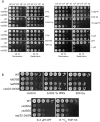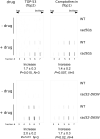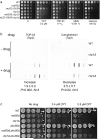Distinct requirements for the Rad32(Mre11) nuclease and Ctp1(CtIP) in the removal of covalently bound topoisomerase I and II from DNA
- PMID: 19150433
- PMCID: PMC2675033
- DOI: 10.1016/j.molcel.2008.11.021
Distinct requirements for the Rad32(Mre11) nuclease and Ctp1(CtIP) in the removal of covalently bound topoisomerase I and II from DNA
Abstract
For a cancer cell to resist treatment with drugs that trap topoisomerases covalently on the DNA, the topoisomerase must be removed. In this study, we provide evidence that the Schizosaccharomyces pombe Rad32(Mre11) nuclease activity is involved in the removal of both Top2 from 5' DNA ends as well as Top1 from 3' ends in vivo. A ctp1(CtIP) deletion is defective for Top2 removal but overproficient for Top1 removal, suggesting that Ctp1(CtIP) plays distinct roles in removing topoisomerases from 5' and 3' DNA ends. Analysis of separation of function mutants suggests that MRN-dependent topoisomerase removal contributes significantly to resistance against topoisomerase-trapping drugs. This study has important implications for our understanding of the role of the MRN complex and CtIP in resistance of cells to a clinically important group of anticancer drugs.
Figures




Similar articles
-
Ctp1CtIP and Rad32Mre11 nuclease activity are required for Rec12Spo11 removal, but Rec12Spo11 removal is dispensable for other MRN-dependent meiotic functions.Mol Cell Biol. 2009 Apr;29(7):1671-81. doi: 10.1128/MCB.01182-08. Epub 2009 Jan 12. Mol Cell Biol. 2009. PMID: 19139281 Free PMC article.
-
A conserved Ctp1/CtIP C-terminal peptide stimulates Mre11 endonuclease activity.Proc Natl Acad Sci U S A. 2021 Mar 16;118(11):e2016287118. doi: 10.1073/pnas.2016287118. Proc Natl Acad Sci U S A. 2021. PMID: 33836577 Free PMC article.
-
Molecular characterization of the Schizosaccharomyces pombe nbs1+ gene involved in DNA repair and telomere maintenance.Mol Cell Biol. 2003 Sep;23(18):6553-63. doi: 10.1128/MCB.23.18.6553-6563.2003. Mol Cell Biol. 2003. PMID: 12944481 Free PMC article.
-
CtIP/Ctp1/Sae2, molecular form fit for function.DNA Repair (Amst). 2017 Aug;56:109-117. doi: 10.1016/j.dnarep.2017.06.013. Epub 2017 Jun 9. DNA Repair (Amst). 2017. PMID: 28623092 Free PMC article. Review.
-
Ctp1/CtIP and the MRN complex collaborate in the initial steps of homologous recombination.Mol Cell. 2007 Nov 9;28(3):351-2. doi: 10.1016/j.molcel.2007.10.016. Mol Cell. 2007. PMID: 17996697 Review.
Cited by
-
NEDDylated Cullin 3 mediates the adaptive response to topoisomerase 1 inhibitors.Sci Adv. 2022 Dec 9;8(49):eabq0648. doi: 10.1126/sciadv.abq0648. Epub 2022 Dec 9. Sci Adv. 2022. PMID: 36490343 Free PMC article.
-
MRE11-RAD50-NBS1 complex alterations and DNA damage response: implications for cancer treatment.Mol Cancer. 2019 Nov 26;18(1):169. doi: 10.1186/s12943-019-1100-5. Mol Cancer. 2019. PMID: 31767017 Free PMC article. Review.
-
Tyrosyl-DNA Phosphodiesterase 1 (Tdp1) inhibitors.Expert Opin Ther Pat. 2011 Sep;21(9):1285-92. doi: 10.1517/13543776.2011.604314. Expert Opin Ther Pat. 2011. PMID: 21843105 Free PMC article. Review.
-
Mre11 exonuclease activity removes the chain-terminating nucleoside analog gemcitabine from the nascent strand during DNA replication.Sci Adv. 2020 May 29;6(22):eaaz4126. doi: 10.1126/sciadv.aaz4126. eCollection 2020 May. Sci Adv. 2020. PMID: 32523988 Free PMC article.
-
The extent of error-prone replication restart by homologous recombination is controlled by Exo1 and checkpoint proteins.J Cell Sci. 2014 Jul 1;127(Pt 13):2983-94. doi: 10.1242/jcs.152678. Epub 2014 May 7. J Cell Sci. 2014. PMID: 24806966 Free PMC article.
References
-
- Baldwin EL, Osheroff N. Etoposide, topoisomerase II and cancer. Curr Med Chem Anticancer Agents. 2005;5:363–72. - PubMed
-
- Champoux JJ. DNA TOPOISOMERASES: Structure, Function, and Mechanism. Annual Review of Biochemistry. 2001;70:369–413. - PubMed
-
- Connelly JC, de Leau ES, Leach DRF. Nucleolytic processing of a protein-bound DNA end by the E. coli SbcCD (MR) complex. DNA Repair (Amst.) 2003;2:795–807. - PubMed
-
- Connelly JC, Leach DRF. Repair of DNA Covalently Linked to Protein. Molecular Cell. 2004;13:307–316. - PubMed
Publication types
MeSH terms
Substances
Grants and funding
LinkOut - more resources
Full Text Sources
Molecular Biology Databases
Research Materials
Miscellaneous

